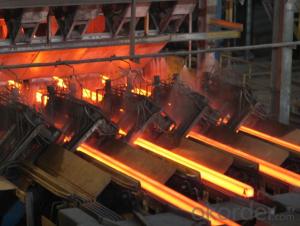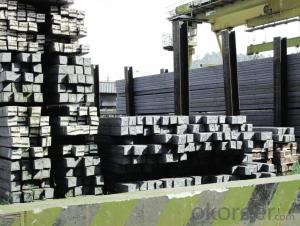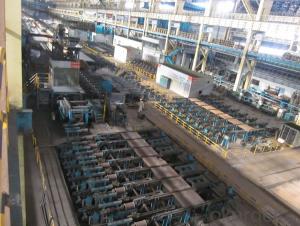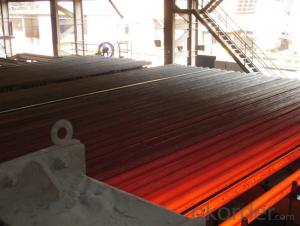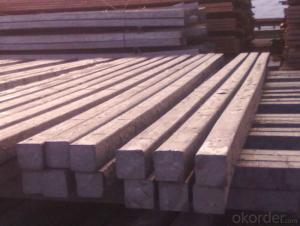Hot Rolled Steel Billet 3SP Standard 110mm
- Loading Port:
- Shanghai
- Payment Terms:
- TT OR LC
- Min Order Qty:
- 100 m.t.
- Supply Capability:
- 10000 m.t./month
OKorder Service Pledge
OKorder Financial Service
You Might Also Like
Structure of Hot Rolled Steel Billet 3SP Standard 110mm

Description of Hot Rolled Steel Billet 3SP Standard 110mm
Prepainted Rolled steel Coil is a kind of coated steel coil/sheet. With the cold rolled steel of different strength and thickness as substrate, it is produced through applying Al-Zn coat on both faces by hot dip process. In its coating, Al accounts for about 55%, Si 1.6%, while the remaining is Zn. Aluminum zinc coils enjoys both the physical protective feature and durability of Al and the electrochemical protective property of Zn. And its surface has bright silver color and regular embossed-like figure, which are highly decorative. RAL Scale Z35 Prepainted Rolled Steel Coil for Construction Roofing

Main Feature of Hot Rolled Steel Billet 3SP Standard 110mm
1.Corrosion resistance: It mainly depends on the zinc protection. When the zinc being worn,
2. Heat resistance: steel sheet has excellent heat resistance, can withstand high temperatures over 300 centigrade, and is similar with aluminized steel high temperature oxidation resistance. It often used in chimney pipes, ovens, fluorescent lighting device and the device cover.
3. Heat reflective: Galvanized steel plate heat-reflective high rate is twice as galvanized steel, often used to make insulation materials. RAL Scale Z35 Prepainted Rolled Steel Coil for Construction Roofing
Applications of Hot Rolled Steel Billet 3SP Standard 110mm
1. Construction and building: roofing; ventilating duct; handrail; partition panel;etc.
2. Electric appliance: refrigerator; washing machine; refrigerator; DVD;etc.
3.Transportation: oil tank; gas tank;road sign; etc.
4.Agriculture constructions :barn; etc.RAL Scale Z35 Prepainted Rolled Steel Coil for Construction Roofing
5.Others:vending machine; game machine; auto parts spare parts etc.
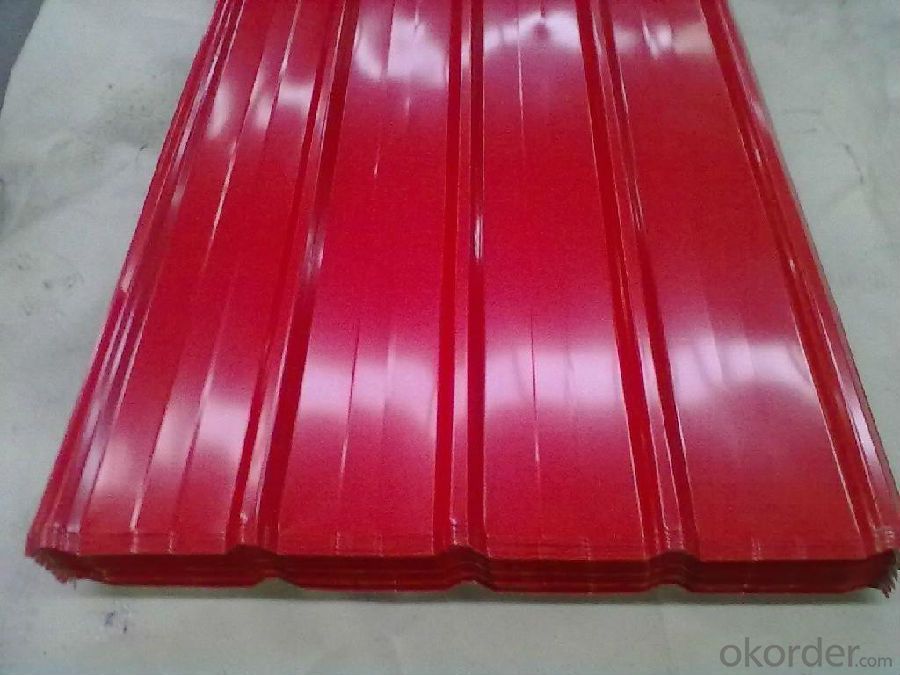
Specifications of Hot Rolled Steel Billet 3SP Standard 110mm
Product | Hot Rolled Steel Billet 3SP Standard 110mm |
Material Grade | SGCC / SGCH / DX51D+AZ, etc |
Thickness | 0.5-3.0mm |
Width | 700-1500mm |
Tolerance | Thickness: +/-0.02mm , Width:+/-2mm |
Zinc-coating | AZ30-150g/m2 |
Technique | Raw material: Hot rolled steel coil --> Cold rolled_>hot dipped galvalume |
Surface | Dried, Chromated, Unoiled,RAL Scale Z35 Prepainted Rolled Steel Coil for Construction Roofing |
Spangle | Regular spangle , small spangle, zero spangle |
ID | 508MM 610MM |
Coil weight | 25MT max |
Export package | Cardboard inner sleeves, Waterproof paper, galvanized steel covered and steel strip packed |
FAQ of Hot Rolled Steel Billet 3SP Standard 110mm
We have organized several common questions for our clients,may help you sincerely:
1. What is the minimum order quantity ?
Our MOQ is 100 mt for each size each specification. Usually we can offer discount if can buy large QTY once. RAL Scale Z35 Prepainted Rolled Steel Coil for Construction Roofing
2. How long can we receive the product after ordering?
Our general delivery time is 30 days after confirmation, but so some special orders, we have offer special delivery time
3. How to guarantee the quality of the products?
We have established the international advanced quality management system ,every link from raw material to final product we have strict quality test;We resolutely put an end to unqualified products flowing into the market. At the same time, we will provide necessary follow-up service assurance.
4. What is the payment?
We accept T/T, L/C
- Q:How are steel billets tested for internal defects?
- Steel billets are tested for internal defects through a variety of non-destructive testing methods. One of the most common methods used is ultrasonic testing (UT). During this process, high-frequency sound waves are transmitted into the billet, and the reflections of these waves are analyzed to detect any internal defects such as cracks, voids, or inclusions. UT can provide accurate and detailed information about the size, location, and nature of the defects. Another method used is magnetic particle inspection (MPI). This technique involves magnetizing the billet and applying iron particles to its surface. If there are any internal defects, the magnetic field will cause these particles to gather around them, making them visible and detectable. Eddy current testing (ECT) is also employed to assess the internal quality of steel billets. It utilizes electromagnetic induction to create eddy currents within the material. Any changes in the electrical conductivity or magnetic permeability caused by internal defects can be detected by analyzing the variations in the induced current. Additionally, radiographic testing (RT) is utilized to inspect the internal structure of steel billets. X-rays or gamma rays are directed towards the billet, and the resulting radiographic image can reveal any internal defects such as voids, cracks, or inclusions. Other methods, such as dye penetrant testing and visual inspection, can also be used to detect superficial and near-surface defects in steel billets. These methods involve applying a liquid or dye to the surface of the billet, which will seep into any cracks or surface irregularities, making them visible under certain lighting conditions. Overall, a combination of these non-destructive testing methods is employed to ensure the quality and integrity of steel billets by effectively detecting any internal defects that could compromise their structural integrity and performance.
- Q:How are steel billets used in the production of axles?
- Steel billets are used in the production of axles as a starting material. They are heated and shaped through forging or rolling processes to form the desired axle shape. This ensures the axle has the necessary strength and durability to support the weight and withstand the forces experienced during operation.
- Q:What is the typical elongation of a steel billet?
- The typical elongation of a steel billet can vary depending on several factors such as the specific grade of steel, the manufacturing process, and the intended application. However, in general, the elongation of a steel billet is typically around 20% to 30%. Elongation is a measure of a material's ability to deform or stretch before breaking. It is usually expressed as a percentage and is determined by conducting a tensile test on a sample of the material. During this test, the sample is subjected to gradually increasing tensile forces until it eventually fractures. The amount of elongation is measured by comparing the original length of the sample to its final length at the point of fracture. Steel is known for its high tensile strength, which means it can withstand significant forces without breaking. However, it also exhibits a certain degree of ductility, allowing it to elongate before reaching its breaking point. The typical elongation of a steel billet falls within the range mentioned above, indicating that it can stretch by 20% to 30% of its original length before fracturing. It's important to note that different grades of steel can have varying elongation properties. For example, higher carbon steels tend to have lower elongation values compared to low carbon or mild steels. Additionally, the manufacturing process can also affect the elongation of a steel billet. Processes such as hot rolling or cold drawing can modify the microstructure of the steel, thereby influencing its elongation characteristics. Ultimately, the specific elongation requirements for a steel billet will depend on the intended application. Certain industries, such as construction or automotive, may require steel with higher elongation values to ensure the material can withstand the stresses and strains it will encounter during use. Conversely, other applications may prioritize higher tensile strength over elongation.
- Q:How are steel billets used in the manufacturing of telecommunications equipment?
- Steel billets are an essential component in the manufacturing of telecommunications equipment. These billets serve as the raw material that is shaped and transformed into various components used in telecommunications infrastructure. One of the primary uses of steel billets in telecommunications equipment manufacturing is in the production of towers and masts. These structures provide the necessary support for antennas and other equipment used in transmitting and receiving signals. Steel billets are melted and then forged or rolled into the desired shape to form the structural members of these towers, ensuring their strength and stability. Additionally, steel billets are also used in the manufacturing of cable trays and cable management systems. These components are crucial for organizing and protecting the vast network of cables that are used in telecommunications systems. Steel billets are processed and fabricated into cable trays, brackets, and supports, providing a sturdy and durable solution for managing the complex web of cables. Furthermore, steel billets find application in the production of enclosures and cabinets used to house sensitive telecommunications equipment. These enclosures provide protection from environmental factors such as dust, moisture, and temperature fluctuations. Steel billets are molded and shaped into the desired size and design, ensuring a robust and secure enclosure for the equipment. In summary, steel billets play a vital role in the manufacturing of telecommunications equipment. From towers and masts to cable trays and enclosures, these billets provide the foundation and structural integrity necessary for the reliable operation of telecommunications infrastructure.
- Q:What are the different types of coating processes used for protecting steel billets?
- There are several different types of coating processes used for protecting steel billets. These processes aim to prevent corrosion and improve the durability of the steel billets. Some of the commonly used coating processes include: 1. Hot-dip galvanizing: This process involves dipping the steel billets into a bath of molten zinc. The zinc forms a protective layer on the surface of the steel, preventing corrosion and providing long-lasting protection. 2. Electroplating: In this process, a thin layer of metal such as zinc, nickel, or chrome is deposited onto the surface of the steel billets using an electric current. The metal layer acts as a barrier against corrosion and enhances the appearance of the steel. 3. Powder coating: Powder coating involves applying a dry powder onto the surface of the steel billets, which is then heated to form a protective layer. This process provides excellent resistance to corrosion, chemicals, and UV rays. 4. Thermal spray coating: This process involves spraying a melted or heated material onto the surface of the steel billets. The coating material can be metal alloys, ceramics, or polymers. Thermal spray coatings offer high wear resistance, corrosion protection, and thermal insulation. 5. Paint coating: Applying paint onto the surface of steel billets is a common method of protection. The paint acts as a barrier against moisture and atmospheric elements, preventing corrosion and maintaining the appearance of the steel. Each of these coating processes has its own advantages and is suitable for different applications. The choice of coating process depends on factors such as the desired level of protection, environmental conditions, and cost considerations.
- Q:How do steel billets contribute to the manufacturing of sports gear?
- The manufacturing of sports gear heavily relies on steel billets, which play an essential role. These semi-finished products, either cylindrical or square-shaped, are created by pouring liquid steel into molds and allowing them to solidify. Once formed, steel billets are further processed to produce various sports equipment like golf clubs, tennis rackets, baseball bats, and hockey sticks. One of the primary reasons behind the utilization of steel billets in sports gear production is their remarkable strength and durability. Steel possesses high tensile strength, enabling it to withstand considerable force without breaking or deforming. This quality makes it an ideal material for sports equipment that demands resilience and long-lasting performance. Moreover, steel billets offer exceptional flexibility and customization options in terms of design and performance. Manufacturers can shape and mold the billets to create diverse types of sports gear, incorporating specific features to enhance performance. For instance, golf club heads are frequently crafted from steel billets, allowing manufacturers to manipulate the weight distribution for optimal swing dynamics and increased distance. Additionally, steel billets contribute to the performance of sports gear by providing stability and control. The rigid nature of steel ensures that the equipment maintains its shape and does not experience excessive vibrations during use. This stability is particularly crucial in sports like tennis or hockey, where precise control and accuracy are paramount. Furthermore, steel billets can be combined with other materials to produce composite sports gear. By integrating steel with materials such as carbon fiber or titanium, manufacturers can create lightweight yet incredibly strong equipment. This combination allows for improved maneuverability and overall performance. In conclusion, steel billets are indispensable components in sports gear manufacturing due to their exceptional strength, durability, flexibility, and customization options. From golf clubs to hockey sticks, steel billets contribute to the creation of high-quality sports equipment that offers stability, control, and enhanced performance for athletes.
- Q:How are steel billets used in the production of machined parts?
- Steel billets are used in the production of machined parts as the starting material. They are heated and shaped into various forms, such as bars, rods, or tubes, which can then be further processed through machining operations like cutting, drilling, or milling. This allows for the creation of precise and complex components used in various industries, including automotive, aerospace, and machinery.
- Q:What are the potential applications of steel billets in the aerospace industry?
- Steel billets have several potential applications in the aerospace industry. They can be used for the manufacturing of various components such as engine parts, landing gear components, and structural elements. The high strength and durability of steel billets make them suitable for ensuring the structural integrity and safety of aircraft. Additionally, their excellent heat resistance properties make them ideal for applications in the aerospace industry where high temperatures are encountered, such as in jet engines.
- Q:What are the different surface treatments for improved wear resistance in steel billets?
- Steel billets can be subjected to various surface treatments to enhance their wear resistance. These treatments aim to increase the durability and longevity of the steel, making it more resilient against wear and tear. One widely utilized surface treatment method is case hardening. This technique involves heating the steel billets to high temperatures and then rapidly cooling them in a quenching medium, like oil or water. This process results in the formation of a tough outer layer, known as a case, while maintaining a comparatively softer core. The hardened case provides exceptional wear resistance, while the softer core retains toughness and ductility. Nitriding is another surface treatment option for improved wear resistance. This process entails introducing nitrogen into the surface of the steel billets, typically through a gas or plasma-based approach. The nitrogen permeates the steel and forms a hard layer of nitride on the surface. This nitride layer significantly enhances the hardness and wear resistance of the steel, making it suitable for applications requiring high wear resistance. Hard chrome plating is a third surface treatment technique. It involves electroplating a layer of chromium onto the surface of the steel billets. The chromium layer offers excellent wear and corrosion resistance, making it ideal for applications where the steel will be exposed to harsh environments or abrasive substances. Furthermore, advanced surface treatment methods such as physical vapor deposition (PVD) and chemical vapor deposition (CVD) can be employed to enhance the wear resistance of steel billets. These processes involve depositing a thin film of a wear-resistant material, like titanium nitride or diamond-like carbon, onto the steel's surface. These thin films create a hard and low-friction surface, improving wear resistance and reducing frictional losses. In summary, these surface treatments present a diverse range of options to improve the wear resistance of steel billets. The choice of treatment depends on factors such as the specific application requirements, desired level of wear resistance, and budget constraints. Seeking guidance from materials experts or surface treatment specialists can aid in determining the most suitable treatment for a particular steel billet application.
- Q:How are steel billets used in the manufacturing of railway components?
- Steel billets are used in the manufacturing of railway components as they serve as the raw material for forging and shaping various parts like rails, wheels, axles, and other structural components. These billets are heated and then manipulated through processes like rolling and forging to obtain the desired shape and strength required for railway applications.
1. Manufacturer Overview |
|
|---|---|
| Location | |
| Year Established | |
| Annual Output Value | |
| Main Markets | |
| Company Certifications | |
2. Manufacturer Certificates |
|
|---|---|
| a) Certification Name | |
| Range | |
| Reference | |
| Validity Period | |
3. Manufacturer Capability |
|
|---|---|
| a)Trade Capacity | |
| Nearest Port | |
| Export Percentage | |
| No.of Employees in Trade Department | |
| Language Spoken: | |
| b)Factory Information | |
| Factory Size: | |
| No. of Production Lines | |
| Contract Manufacturing | |
| Product Price Range | |
Send your message to us
Hot Rolled Steel Billet 3SP Standard 110mm
- Loading Port:
- Shanghai
- Payment Terms:
- TT OR LC
- Min Order Qty:
- 100 m.t.
- Supply Capability:
- 10000 m.t./month
OKorder Service Pledge
OKorder Financial Service
Similar products
New products
Hot products
Related keywords

